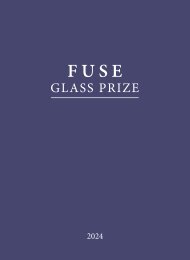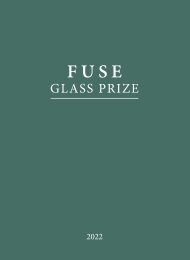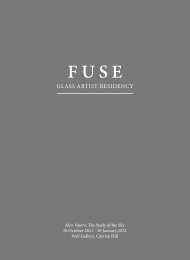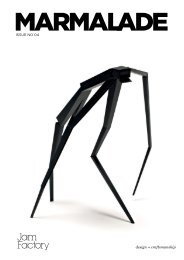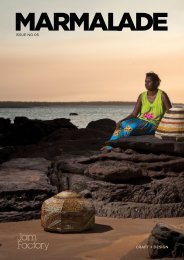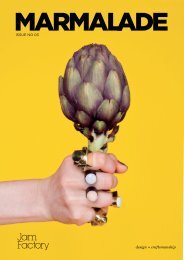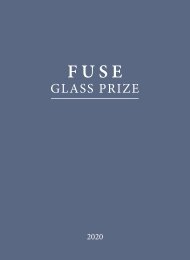FUSE Glass Artist Residency
Marcel Hoogstad Hay: Sublime Scales
Marcel Hoogstad Hay: Sublime Scales
- No tags were found...
You also want an ePaper? Increase the reach of your titles
YUMPU automatically turns print PDFs into web optimized ePapers that Google loves.
GLASS ARTIST RESIDENCY<br />
Marcel Hoogstad Hay: Sublime Scales<br />
4 November 2023 - 28 January 2024<br />
Wall Gallery, Carrick Hill
Contents<br />
Introduction 2<br />
Donors 5<br />
Sublime Scales 7<br />
Then the squashed and densified and 10<br />
compressed and rounded mirroring<br />
of Marcel’s work pings<br />
Presenters 23<br />
Credits 24
Introduction<br />
JamFactory and Carrick Hill are proud<br />
to present the 2023 <strong>FUSE</strong> <strong>Glass</strong> <strong>Artist</strong><br />
<strong>Residency</strong> Exhibition.<br />
Awarded biennially in alternate years to<br />
the <strong>FUSE</strong> <strong>Glass</strong> Prize, the <strong>FUSE</strong> <strong>Glass</strong> <strong>Artist</strong><br />
<strong>Residency</strong> aims to create significant<br />
opportunities for established, mid-career<br />
artists working in glass. The residency at<br />
JamFactory in Adelaide enables a selected<br />
artist to work with skilled assistants, take risks<br />
and experiment with the development of new<br />
work using or incorporating hot blown glass.<br />
Adelaide-based artist Marcel Hoogstad Hay<br />
was selected from a competitive field of<br />
applicants as the 2023 recipient of the <strong>FUSE</strong><br />
<strong>Glass</strong> <strong>Artist</strong> <strong>Residency</strong> and we are grateful<br />
to the three judges who assessed the<br />
applications - venerated South Australian<br />
glass artist Clare Belfrage, the Head of<br />
JamFactory’s <strong>Glass</strong> Studio Kristel Britcher<br />
and Carrick Hill Board Member Jeff Mincham.<br />
Hoogstad Hay has spent over 10 years<br />
working with glass. He graduated from the<br />
ANU School of Art and Design, Canberra in<br />
2012 and completed the Associate Program<br />
at JamFactory in 2014. He was a finalist in<br />
the <strong>FUSE</strong> <strong>Glass</strong> Prize in 2020 and the<br />
Tom Malone Prize in 2021 and 2022.<br />
As a local artist, Hoogstad Hay chose to<br />
undertake his residency over two intense<br />
blocks in June and July 2023. New work<br />
developed through the residency is the focus<br />
of this solo exhibition presented in the Wall<br />
Gallery at Carrick Hill from 4 November 2023<br />
to 28 January 2024.<br />
The <strong>FUSE</strong> <strong>Glass</strong> <strong>Artist</strong> <strong>Residency</strong> has been<br />
developed as an extension of the successful<br />
<strong>FUSE</strong> <strong>Glass</strong> Prize. It provides a platform to<br />
encourage artists residing in Australia or<br />
New Zealand working in glass, to push<br />
themselves and their work to new limits,<br />
and to focus significant public attention on<br />
the importance of glass as a medium for<br />
contemporary artistic expression. The biennial<br />
prize, which was established by JamFactory<br />
in 2016, is a juried, non-acquisitive, $20,000<br />
cash prize for established artists. An<br />
additional prize – the David Henshall<br />
Emerging <strong>Artist</strong> Prize, valued at $10,000,<br />
is awarded to an emerging glass artist.<br />
fuseglassprize.com<br />
2
Vanishing Points, 2023<br />
blown and mirrored glass. Photo: Pippy Mount
Donors<br />
Thank you to our donors.<br />
The <strong>FUSE</strong> <strong>Glass</strong> Prize and <strong>Residency</strong><br />
program is a shining example of how<br />
collective philanthropic support can<br />
create great opportunities for artists and<br />
add extraordinary value to the work of<br />
arts organisations.<br />
The prize evolved from conversations that<br />
began in 2014 between committed glass<br />
art collectors Jim and Helen Carreker and<br />
JamFactory. The <strong>FUSE</strong> <strong>Glass</strong> Prize launched<br />
in 2016 and was funded then, as it is now,<br />
predominantly through private philanthropy<br />
and sponsorship.<br />
The Carrekers’ steadfast support has been<br />
ongoing. They gifted additional funds in<br />
2020 to enable significant evolution of the<br />
prize – including the development of the<br />
<strong>FUSE</strong> <strong>Glass</strong> <strong>Artist</strong> <strong>Residency</strong> in the alternate<br />
years of the prize. Most recently the Carrekers<br />
have very generously provided further funds<br />
to set up an endowment that will ensure this<br />
important new residency component will be<br />
well supported throughout this decade.<br />
With this latest commitment, the Carrekers’<br />
personal philanthropic support of <strong>FUSE</strong><br />
remains the most significant private support<br />
in JamFactory’s history.<br />
The <strong>FUSE</strong> <strong>Glass</strong> <strong>Artist</strong> <strong>Residency</strong> Exhibition<br />
at Carrick Hill has once again been made<br />
possible by the additional generosity of<br />
Pamela Wall OAM and Ian Wall AM<br />
(1931 - 2022) who have been committed<br />
and long-term supporters of Carrick Hill.<br />
The new purpose-built exhibition space,<br />
in which this exhibition is presented, was<br />
named the Wall Gallery in their honour.<br />
The <strong>FUSE</strong> <strong>Glass</strong> Prize is supported by the<br />
following donors; Jim and Helen Carreker,<br />
the Hon Diana Laidlaw AM, David McKee AO<br />
and Pam McKee, the David & Dulcie Henshall<br />
Foundation, Pamela Wall OAM and Ian Wall<br />
AM (1931 - 2022), Susan Armitage,<br />
Sonia Laidlaw and Maia Ambegaokar<br />
and Joshua Bishop.<br />
Marcel at work in the <strong>Glass</strong> Studio<br />
Photo: Connor Patterson<br />
5
Sublime Scales<br />
Marcel Hoogstad Hay is interested in<br />
the ways people perceive the world; our<br />
perceptions of space, time and matter,<br />
and how these preconceived notions<br />
relate to the way things appear when<br />
viewed at different scales. He is fascinated<br />
by the way spacetime is influenced by the<br />
physical forces in the universe and, using<br />
the material and optical qualities of<br />
glass, he explores this idea through the<br />
distortion of image, pattern and form.<br />
For this exhibition Sublime Scales,<br />
Hoogstad Hay has created a body of work<br />
that addresses how we situate ourselves<br />
in the world as we move through it.<br />
Working with traditional Venetian glass<br />
cane techniques he creates complex,<br />
gestural patterns. These lines of cane<br />
allude to paths traversed and how<br />
physical forces disrupt and distort these<br />
paths. They reference the nature of things<br />
when viewed at a quantum scale, but also<br />
topography and how we might picture<br />
ourselves moving across the Earth’s<br />
surface. It is in the nature of these<br />
often unseen scales, the unfathomability<br />
of the astronomical and the complexity<br />
of the quantum, that Hoogstad Hay finds<br />
a sense of awe. Through these works he<br />
explores perceptual elements, breaking<br />
down our established understanding of<br />
the physical world. The reflective surfaces<br />
and absorbing interiors of these objects<br />
invite the viewer to engage with the work,<br />
and to contemplate the self and our place<br />
in the universe.<br />
Wine Dark Sea II, 2023<br />
blown and mirrored glass, acrylic paint. Photo: Pippy Mount<br />
7
Then the squashed<br />
and densified and<br />
compressed and<br />
rounded mirroring of<br />
Marcel’s work pings<br />
by Robert Cook<br />
As usual I start to type and find I can’t<br />
read my notes. Tiny little spider writing. In<br />
mechanical pencil. Lines connecting half<br />
sentences. They are not ‘helpful’. None of it is<br />
‘helpful’. I wonder, though: were they meant to<br />
be? If I take it that there is an unconscious, I<br />
could interpret myself as fashioning a teasing<br />
tangle of responses and echoes to Marcel’s<br />
words and work that undoes my capacity to<br />
be a transparent medium. Of course, I hate<br />
this about myself. The insertion thing. My<br />
galumphing presence; I so want to overcome<br />
my grotesque need to be visible, or audible,<br />
whatever it is. Weirdly though, it’s not just<br />
manners. Isn’t there a sneaky little trajectory<br />
that is in fact a not-so-little not-so-sneaky<br />
trajectory of dudes being hidden and<br />
occupying stances of neutrality that aren’t<br />
that? That guide and guard and shape and<br />
shade so that their power (look how I<br />
distance myself here, their) is hidden,<br />
naturalised. Neutralised in a way that’s<br />
anything but.<br />
Previous page: Cosmic Wiggle Cluster, 2023<br />
blown and mirrored glass, acrylic paint. Photo: Pippy Mount<br />
Trace No. 6, 2023<br />
blown and mirrored glass. Photo: Pippy Mount<br />
10
And when it’s exposed as kind of being<br />
basically The Structure there is the sudden<br />
shame of the sprung voyeur. The shame of<br />
ideology unmasked as that, as if the stakes<br />
were not declared. Which they weren’t.<br />
And yeah, most of this is then instantly<br />
repressed: ‘No, no that wasn’t happening!’<br />
That’s how this structure functions.<br />
The veracity of this line is supported by all<br />
those analyses of this or that prison/<br />
institutional/social formation whereby folk<br />
modify their behaviours when visible as they<br />
pull the look (of the authority, the jailor, the<br />
dad, the cop, the bank) ‘inside’. All of which is<br />
inherently relational which is why there were/<br />
are centuries of those artists of the mirror<br />
(Velasquez, Dan Graham et al.) who dealt and<br />
deal with what it is to get caught up in the<br />
binds of being a viewer and a viewed, being<br />
in and out of the mechanism, split, splitting,<br />
fractured, lost, corrupted, corrupting,<br />
complicit. We’re wary of these forces even<br />
if its in our bodies and reflex behaviours.<br />
Just note the slip of gaffer tape over your<br />
computer camera and tell me it’s not as<br />
true today as it was in 1656.<br />
Which is, yes, an admittedly super longwinded<br />
way of saying that Marcel’s medium,<br />
glass, even when not mirrored, is totally<br />
implicated in all this stuff. I mean, it’s no<br />
leap at all from the ground glass in Jimmy<br />
Stewart’s telescope in Rear Window to the<br />
great sheets that form the surfaces of the<br />
skyscrapers that create an infinite sky above<br />
us bouncing away in a non-transcendental<br />
corporatised sublime. These notions and<br />
experiences and tensions are all rising and<br />
bubbling and mutating in what Marcel’s been<br />
doing over the last two years or so; and with<br />
increased focus and scale thanks to the <strong>FUSE</strong><br />
<strong>Residency</strong> that has allowed him to go larger<br />
and more complex and draw on the talents of<br />
those around him.<br />
Which is another kind of relationality, and it’s<br />
my sense his work carries that as much as it<br />
carries itself as a series of propositions around<br />
framing our positions in the world. What I<br />
mean by that is that there is a human scale at<br />
one end, whereby the limits of the object are<br />
defined by the scale of the studio, the skills of<br />
the people around, those things, and a way<br />
more micro and macro level that starts to get<br />
positively vertiginous. See, at that level he’s<br />
operating around some pretty heady science<br />
stuff emanating from Carlo Rovelli notions<br />
that time doesn’t exist only space, and that<br />
the universe is a kind of malleable web, that<br />
is stretchable, and that within this we have<br />
a whole related thing about absorption<br />
and reflection, these forces that make<br />
black holes and the like.<br />
You can see how this relates to my preamble<br />
while being another waaaaay big step<br />
outwards from that. His mirrored forms pull<br />
us into this zone where we’re caught by our<br />
distorted reflection, even if this is partial (any<br />
maybe especially so as it pulses us away<br />
from our sense of cohesive form) and what’s<br />
interesting is that he stages this in a manner<br />
Trace No. 5, 2023<br />
blown and mirrored glass. Photo: Pippy Mount<br />
13
that is neither clinical and existentially chilling<br />
nor domesticating and reassuring. Instead,<br />
he remains light and floatingly, teasingly<br />
propositional. From this position, his balance<br />
of cane work motifs and mirrored surfaces<br />
and shapes - both poised and off kilter - offers<br />
a rich framework to speculate on how objects<br />
exist, how earth exists, how both exist in such<br />
a way as to hold us in a place long enough<br />
for us to even begin to get all hung up who<br />
is looking at whom, what is looking at whom.<br />
Thankfully it doesn’t make any ‘oh human<br />
concerns are so petty’ statement but rather<br />
acts out the entanglement of the layers of<br />
scale and reality that we reside within (layers<br />
that those like Lacan have always held in mind<br />
too, of course…the Symbolic pitched ‘against’<br />
the Real).<br />
Yet as well as acting all these layers out,<br />
Marcel insists (in a measured way) that he<br />
diagrams it. Damn, I really like this! We can<br />
see that their diagrammatic basis keeps them<br />
ultimately ‘free’, not to be aesthetic objects<br />
only, or to be symbols or analogies either. It<br />
helps them enter the imaginative gravitational<br />
folds of the mind (does this exist, I’m riffing<br />
here!) where they can function as ideas and<br />
perspectives, tentative theories perhaps too.<br />
One of which, maybe, is the idea of multiple<br />
vanishing points. If perspective is built (in<br />
part) on this notion, a single point, vanishing<br />
point, and its stitching of a viewer and a site<br />
in more or less one place, then the squashed<br />
and densified and compressed and rounded<br />
mirroring of Marcel’s works pings this off in all<br />
kinds of other vanishing points such that we<br />
might imagine ourselves win an endlessly<br />
Singularity, 2023<br />
blown and mirrored glass, acrylic paint. Photo: Pippy Mount<br />
14
Marcel at work in the <strong>Glass</strong> Studio<br />
Photo: Connor Patterson<br />
Traverse No. 5, 2023<br />
blown and mirrored glass. Photo: Pippy Mount
mutating, morphing realm of lines and<br />
pathways, behind and around us, that hints<br />
at other places we can be viewed from,<br />
and see ourselves from, at which point we<br />
might experience a kind of derealization<br />
of self, and get to the idea of the self itself<br />
as a makeshift diagram we’re endlessly<br />
geolocating and not in a neutral sense.<br />
(Echoes of Lacan’s gaze here obviously.)<br />
Which means I think Marcel is properly<br />
experimenting here. He’s running out<br />
networks that test and probe, part hard<br />
science part soft science while making us<br />
aware of the extremely loaded nature of<br />
those terms and how the meaning we make<br />
is always a mapping over something, and an<br />
imaginative experience and exercise, and that<br />
a vanishing point is also a black hole, one that<br />
is many, multiplying, so we can feel it nagging<br />
our too visible selves, making us hold onto<br />
the ground for balance as the earth spins<br />
us around and some law of physics starts<br />
tugging at our glasses and hats and hairpiece<br />
as we get sucked as a globular whole with<br />
all our friends and non-friends and well<br />
everything damned else into an oblivion<br />
that might be another future. Who the hell<br />
knows. Certainly not me. I even can’t read<br />
my own notes.<br />
Robert Cook<br />
Curator of 20th Century Art,<br />
Art Gallery of Western Australia, Perth.<br />
Previous Page: Trace/Traverse, 2023<br />
blown and mirrored glass. Photo: Pippy Mount<br />
Into the Void, 2023<br />
blown and mirrored glass. Photo: Pippy Mount<br />
20
Wine Dark Sea I, 2023<br />
blown and mirrored glass, acrylic paint. Photo: Pippy Mount
Presenters<br />
JamFactory<br />
JamFactory is a unique not-for-profit<br />
organisation located in the Adelaide city<br />
centre and at Seppeltsfield in the Barossa.<br />
It is recognised nationally and internationally<br />
as a centre for excellence in glass, ceramics,<br />
furniture and metal design.<br />
JamFactory’s shops, exhibitions, public<br />
programs and touring exhibitions promote<br />
the best Australian craft and design talent.<br />
All purchases made from JamFactory directly<br />
support our training and exhibition program.<br />
JamFactory’s <strong>Glass</strong> Studio is the longest<br />
running hot glass facility in Australia and one<br />
of the largest and best equipped studios in<br />
the Southern Hemisphere. Associates and<br />
staff, guided by current Studio Head Kristel<br />
Britcher, work together to design and make<br />
corporate awards and gifts, custom one-off<br />
commissions, architectural work and small<br />
production runs. Associates are also mentored<br />
in the development of their own work and are<br />
exposed to the many professional artists who<br />
use the facility to create their work. Through<br />
its Associate Training Program JamFactory<br />
has trained well over 100 glass artists from<br />
across Australia and around the world.<br />
Carrick Hill<br />
Carrick Hill is a significant South Australian<br />
cultural icon and tourism attraction. It<br />
comprises a major heritage building, being<br />
the previous home of Sir Edward and Lady<br />
Ursula Hayward, now an exquisite house<br />
museum displaying an internationally<br />
significant art and furniture collection.<br />
The house sits within a 40 hectare estate,<br />
part landscaped and part native bushland;<br />
with original subsidiary buildings such as<br />
stables and eclectic sculptures scattered<br />
throughout the rambling grounds and<br />
gardens; The property is located close to<br />
the city of Adelaide, in the Adelaide foothills,<br />
with spectacular views stretching to Gulf<br />
St Vincent.<br />
Carrick Hill is fortunate to be one of the<br />
few period homes in Australia to survive<br />
with its original contents almost completely<br />
intact and its grounds undiminished. The<br />
collection contains many significant<br />
architectural and decorative glass objects<br />
including items from Tiffany and Lalique.<br />
In 2021 a new exhibition space – the Wall<br />
Gallery – was created in the loft of the main<br />
house as part of major renovations.<br />
23
First Published in Adelaide, Australia in 2023.<br />
Published to coincide with the 2023<br />
<strong>FUSE</strong> <strong>Glass</strong> <strong>Artist</strong> <strong>Residency</strong> Exhibition,<br />
Marcel Hoogstad Hay: Sublime Scales, shown<br />
at the Wall Gallery, Carrick Hill, Adelaide from<br />
4 November 2023 - 28 January 2024.<br />
Published by JamFactory, 19 Morphett Street,<br />
Adelaide SA 5000<br />
All rights reserved. No part of this publication<br />
may be reproduced, stored in a retrieval system<br />
or transmitted in any form or by any means<br />
without the prior permission in writing from<br />
the publisher. Please forward all enquiries to<br />
contact@jamfactory.com.au<br />
© JamFactory, 2023<br />
Copyright for texts in this publication is held by<br />
JamFactory and the authors. Copyright on all<br />
works of art featured belongs to the individual<br />
artist. All images, unless otherwise credited,<br />
are courtesy of the artists. Copyright for<br />
photographic images is held by the individual<br />
photographers as acknowledged.<br />
Exhibition Curator: Rebecca Freezer<br />
Essay: Robert Cook<br />
Catalogue Designer: Sophie Guiney<br />
JamFactory supports and promotes outstanding<br />
contemporary craft and design through its widely<br />
acclaimed studios, galleries and shops. A unique<br />
not-for-profit organisation located in the<br />
Adelaide city centre and Seppeltsfield in the<br />
Barossa. JamFactory is supported by the South<br />
Australian Government and recognised both<br />
nationally and internationally as a centre<br />
for excellence.<br />
JamFactory acknowledges the support of the<br />
South Australian Government through Arts South<br />
Australia and the assistance of the Visual Arts and<br />
Crafts Strategy, an initiative of the Australian,<br />
State and Territory Governments. JamFactory’s<br />
Exhibitions Program is also assisted by the<br />
Australian Government through the Australia<br />
Council.<br />
JamFactory gratefully acknowledges the<br />
generous donors of the <strong>FUSE</strong> <strong>Glass</strong> Program;<br />
Jim and Helen Carreker and Ian Wall AM<br />
(1931 - 2022) and Pamela Wall OAM, David &<br />
Dulcie Henshall Foundation, David McKee AO<br />
and Pam McKee, Diana Laidlaw AM,<br />
Maia Ambegaokar and Joshua Bishop,<br />
Sonia Laidlaw and Susan Armitage.<br />
JamFactory also acknowledges the generosity<br />
of the supporting sponsors and presenting<br />
partners for the 2023 <strong>FUSE</strong> <strong>Glass</strong> <strong>Artist</strong> <strong>Residency</strong>:<br />
Arts South Australia<br />
24




